In this context, spintronics devices offer a unique combination of features, making them very promising for the implementation of highly sensitive biosensors: magnetoresistive transducers, like giant magnetoresistance (GMR) or tunnelling magnetoresistance (TMR) sensors, are employed for the detection of the magnetic beads, which are used as labels of target molecules. The sensor, or its active area, has to be functionalized with the complementary molecular probe to immobilize the target molecules bound to the beads at its surface, thus giving an electrical signal via the magnetoresistive behaviour of the spintronic transducer.
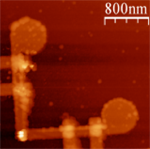 |
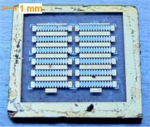 |
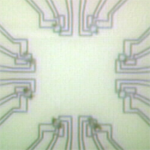 |
The goal of the present project is to advance in the design and realization of microarrays of biosensors based on spintronic transducers,
pushing the limit of detection towards or beyond the actual values of standard bulky techniques based on fluorescence.
The main advantages of this approach are:
- magnetic beads are poorly affected by the environmental conditions, as organic materials (as the fluid in which the beads are suspended, e.g. serum or blood) do not perturb their magnetic properties;
- high sensitivities can be achieved (ideally down to the single molecule) by shrinking the device dimensions to make them comparable to that of the bead and target molecule;
- the reading of the transducers is electric, allowing for a true miniaturization of the diagnostic tool.
The research consortium of the present project is made up of three Units:
- LNESS - Politecnico di Milano
- ICRM-CNR - Institute of Chemistry and Molecular Recognition
- IFOM - Fondazione Istituto FIRC di Oncologia Molecolare
The final aim is developing a lab-on-chip system based on spintronic biosensors with biological sensitivity comparable or better than that of standard bulky systems like fluorescence.
The development of the lab-on-chip will be done with reference to a relevant clinical application which will be used for the comparative validation of the lab-on-chip system, i.e. the measurement of the level of mRNA prep1 in tumors for the identification of patients affected by lung cancer who do not need chemotherapy after a surgical removal.
Objectives
The proposed project aims to enhance understanding and advance in the design and construction of
a new type of compact diagnostic tool for the analysis of biomarkers in biological samples, oriented to point of care medical applications and based on a lab on chip approach including microarrays of spintronic biosensors. As specific application for validation we will consider the identification of patients affected by lung cancer who do not need chemotherapy after a surgical removal of a tumor, via measurements of the level of Prep1 mRNA in biological samples taken during the surgical intervention.
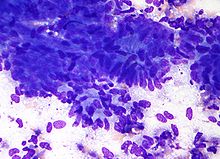
Our design will consist in a chip with 24 sensor points functionalized with specific oligonucleotides and coupled to a microfluidic apparatus for the delivery and transport of the liquids onto the sensor surface.
The realization of spintronic transducers and coatings for probe immobilization is based on the development of innovative materials: complex epitaxial heterostructures are the basic ingredients for the subsequent realization of spintronic devices, via micro and nanofabrication techniques for the lateral definition, and buffer polymeric layers with high density of binding sites uniformly distributed on their surface are necessary for the immobilization of biologic probes.
The following specific objectives will be pursued during the project:
- Development and microfabrication of microarrays of spintronic transducers able
to detect magnetic beads used for labelling the target biomolecules, in a chip with typical dimensions of 10x10mm2 (LNESS)
- Development of protocols for the functionalization of the sensor surface and
magnetic labelling, in order to ensure high sticking efficiency and minimum perturbation of biochemical affinity (ICRM)
- Coupling of the microfluidics to the spintronic chip and development of protocols
for the realization of biological assays (LNESS, ICRM)
- Determination of the performances of spintronic biosensors in prototypical biological assays of DNA recognition (LNESS, ICRM)
- Validation of microarrays of spintronic biosensors with reference to a specific application in molecular oncology (LNESS, ICRM, IFOM)
Personnel
LNESS - Politecnico di Milano |
 |
ICRM-CNR - Institute of Chemistry and Molecular Recognition |
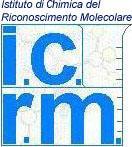 |
IFOM - Fondazione Istituto FIRC di Oncologia Molecolare |
 |
Publications
- : MgO/Fe(001) and MgO/Fe(001)-p(1X1)O interfaces for magnetic tunneling junctions: a comparative study, Phys. Rev. B 80, 104437 (2009).
- : Detection of a single synthetic antiferromagnetic nanoparticle with an AMR nanostructure: comparison between simulations and experiments, J. Phys.: Conf. Ser. 200, 122001 (2010).
- : Nanosized corners for trapping and detecting magnetic nanoparticles, Nanotechnology 20, 385501 (2009).
- : On-Chip Manipulation of Protein-Coated Magnetic Beads via Domain-Wall Conduits, Adv. Materials, (accepted in 2010).
- : On chip nanomanipulation of magnetic particles for cells and molecules handling, 13th International Conference on Miniaturized Systems for Chemistry and Life Sciences (microTAS 2009) Jeju Korea (2009).
- : Domain wall displacement in Py ring for single nanometric magnetic bead detection, Appl. Phys. Lett. 93, 203502 (2008).
Reports
- First year report: PDF file

